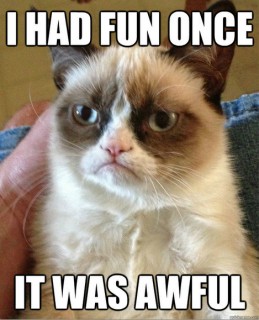
BuzzFeeds Meme of the Year
The other day my daughter had some friends over. Like every other group of teenagers, they were sitting on the couch texting each other. The giggling was infectious so, like any other parent, I asked them what was so funny it was a meme. They were laughing and sharing images on the web with funny messages.
Then I went and logged into my FaceBook, guess what? My news feed consisted of memes, images with words that told a funny joke, story, saying Ah ha! A light went off. Memes, funny, shareable content. I needed more.
What is a Meme -- Pronounced /mim/
- a humorous image, video, piece of text, etc. that is copied (often with slight variations) and spread rapidly by Internet users.
Coined by Richard Dawkins in his 1976 book, The Selfish Gene, the word meme is difficult to define succinctly. Dawkins describes it as a package of culture, in the same way that a gene is a package of genetic information. A meme is an idea that is recognized by many because it is rooted in common knowledge or shared experience.
There are word memes and image memes. A meme often symbolizes a set of related concepts. For instance, Stonehenge is an image meme that symbolizes neolithic religious practices. The term manifest destiny is a word meme that represents the various arguments in favor of the United States becoming a coast-to-coast nation.
Today, in the post internet age, a meme is best thought of as a limited, core concept that can incorporate a range of changed details. For example, the image from the cover of The Beatles album Abbey Road is sometimes used as the jumping off point for adaptations, such as a group of toddlers (or dogs or robots or whatever) crossing a street that has a painted zebra crosswalk. The basic idea of the image remains the same, but the details of text and who is crossing vary according to whatever point the meme creator is hoping to make.
Other recent examples of memes include the well-known photo of Hillary Clinton texting while on an airplane, an image of Tim Tebow tebowing in the end zone of a football field and Shepard Fairey's famous political posters for Barack Obama. All of these have been adapted multiple times by changing the text (and in the case of the Fairy illustrations, the facial features) to convey a different, often humorous, message.
Why Use Memes?
As opposed to traditional advertisements, clever memes are much more likely to go viral, especially in social media. A really good meme is memorable, often funny, and has some sort of emotional impact on the viewer. Memes are easy to share and they provide a common reference point that can connect strangers, as well as friends and acquaintances.
Because some memes are very popular, they generate extensive traffic, which is recognized by the algorithms that drive Facebook and other social sites. Thus, a strong meme will often end up in the news feeds of a great many people, even those who have no prior relationship with your brand or company. Memes are a great way to gain quick visibility and encourage people to click on links that lead to your content.
That Sounds Good, But Complicated. How Do I Create My Own Meme?
Its true that developing a good meme requires an investment of thought and time, but the payoffs can be well worth it.
Six Tips For Developing A Good Meme
1. Consider the ideas and experiences, needs and wants, and pleasure and pain points that your audience shares. Identify a few that have the potential to be moving or humorous or memorable in some other way.
2. Identify the media that your target audience trusts and uses. It is usually most practical to start with social media, since it is more or less free, but traditional paid media like billboards and bus signs can work well too. It all depends on your budget.
3. You can use a meme generator to start your meme or you can create one from scratch. If you're new to meme creation, it may be simpler to start with a generator site such as https://memegenerator.net , https://memecrunch.com , or https://zipmeme.com .
4. Once you decide on your basic meme image, do a Google search to see where the image turns up and who else has used it. Take care to check whether the image has a copyright notice attached and be sure to avoid using images that are obviously problematic, such as Disney characters and corporate logos. You don't want legal trouble.
5. Write various text lines that are compatible with the picture, but unusual in some way. Be aware that there is a thin line between quirky and offensive. Check your text for words that might be misconstrued as insults to a particular group of people. Memes may travel widely and not everyone who sees your meme may share your culture, values or sense of humor.
6. Put your two or three best text lines together with your image(s) and then test, test, test them with others. Its especially helpful if you can test them with members of your primary target audience, but the views of your friends, colleagues and family are useful too. Do everything you can to ensure that your meme is memorable in a GOOD way.
Bear in mind that the purpose of developing a meme is to gain attention for your content. The meme, however successful, is not an end in itself. Ideally, your meme will draw attention to your business and traffic to your website.
Meme Examples
If you'd like to see some good examples of funny memes, check out these links:
While you are at it, send me some meme's that are your favorite.
